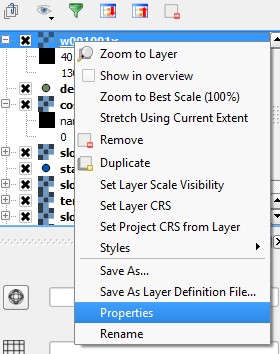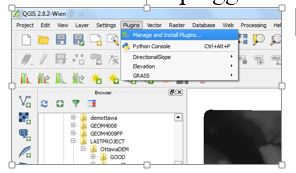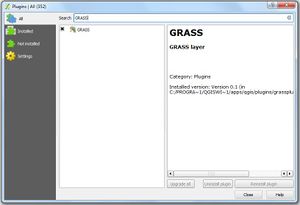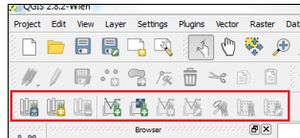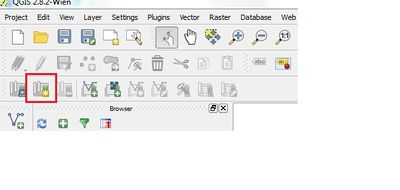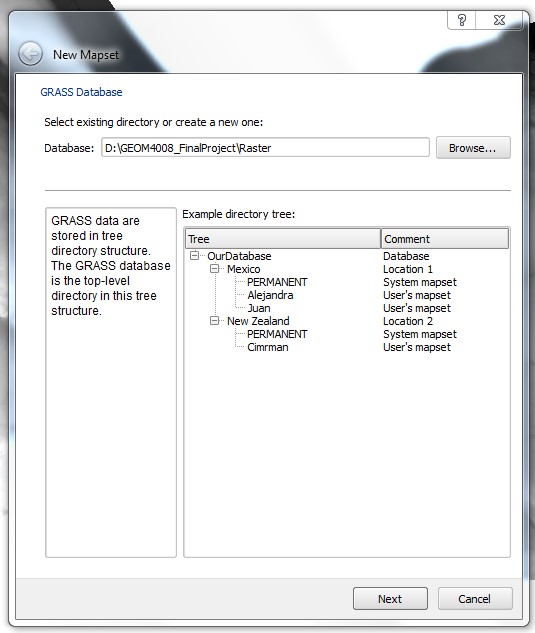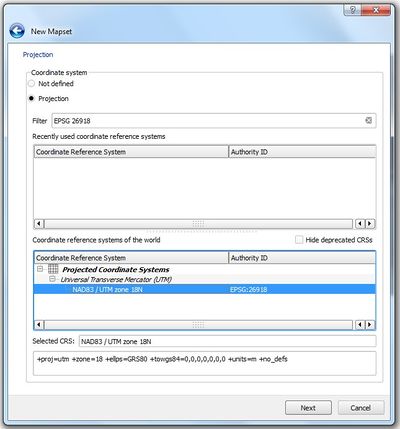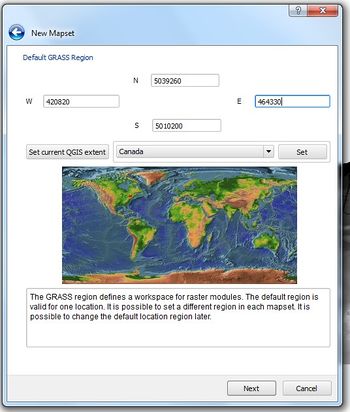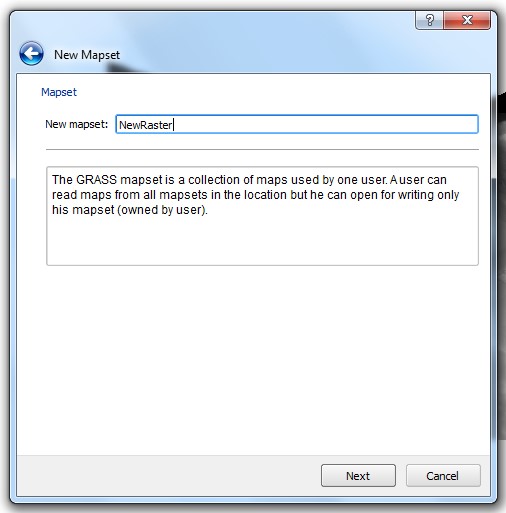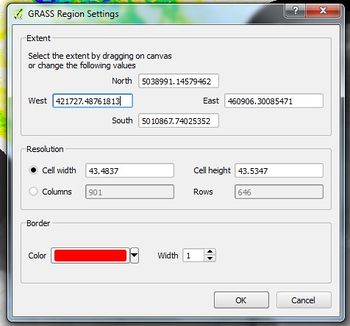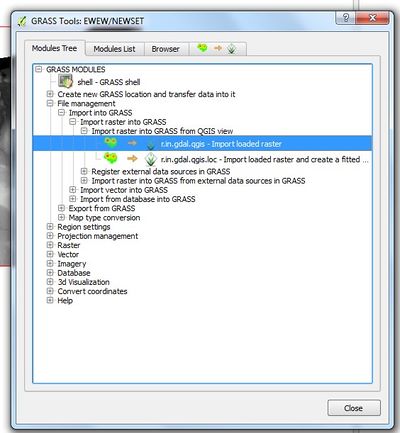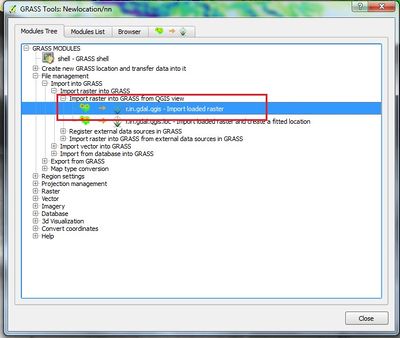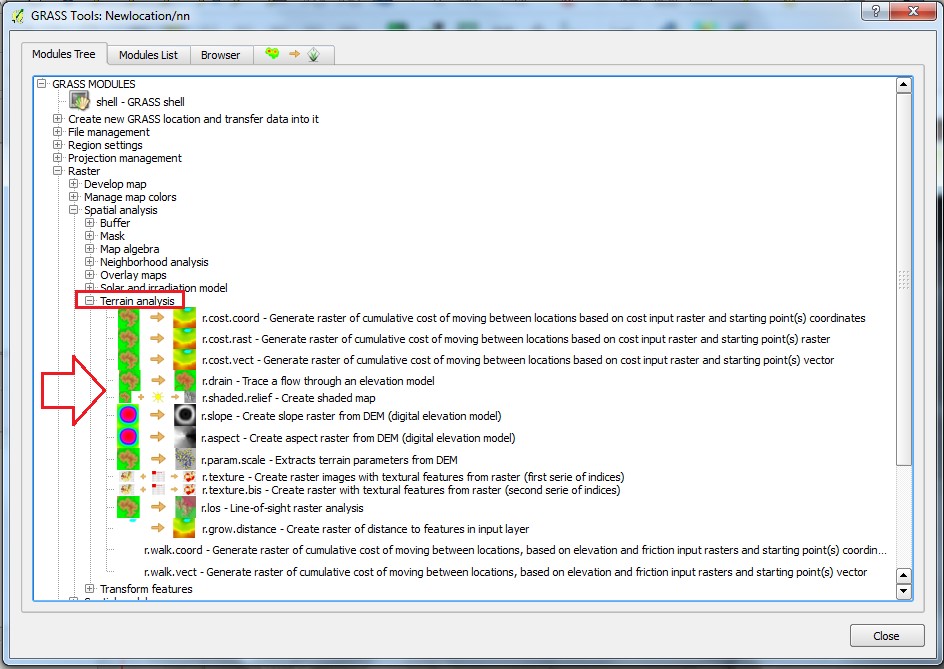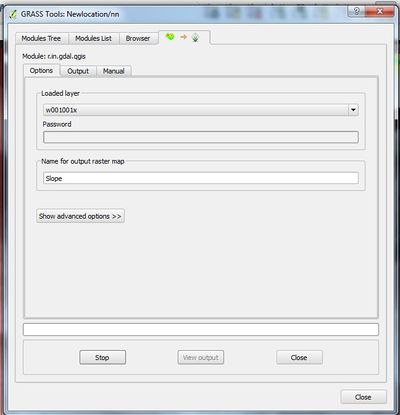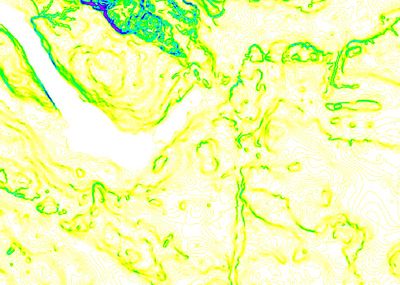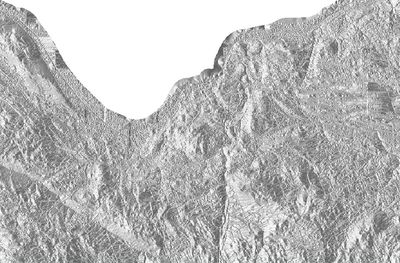Difference between revisions of "Terrain Analysis with GRASS tools in QGIS"
Kirkhenike (talk | contribs) (initial page creation) |
Kirkhenike (talk | contribs) (Section 4 Modified) |
||
| Line 4: | Line 4: | ||
| − | This Wiki page has been created for Advanced Topics in Geographic Information Systems (GEOM4008) student at Carleton University. The main purpose of this tutorial is to introduce and familiarize future users to understand the Raster Terrain analysis with Geographic Analysis Support Analysis Support System (GRASS) tools in QGIS. |
+ | This Wiki page has been created for Advanced Topics in Geographic Information Systems (GEOM4008) student at Carleton University. The main purpose of this tutorial is to introduce and familiarize future users to understand the Raster Terrain analysis with Geographic Analysis Support Analysis Support System (GRASS) tools in QGIS. Many familiar topics will touched upon, know that a basic understanding of geomatics or similar fields of study are needed as the complexity and the terminology are subjective based on geomatics and data processing like techniques. |
== 2 Objective == |
== 2 Objective == |
||
| + | The purpose of this tutorial is to touch on the concept of terrain based analysis using raster data. It will also include a work flow with detailed information into each step as to why the specified steps are important. Other general concepts and functionalities are also to be found with quick tips and tricks. Due to the specificity of GRASS tools and the QGIS workspace many steps will have to be repeated to ensure proper procedures and develop the appropriate data. The Area Of Interest (AOI) includes Gatineau Park, this analysis details the steps to create an elevation and depression model based on various resolutions. |
||
| − | The objective of this tutorial would be to introduce the procedure of plugin functionalities of GRASS tools within a QGIS workspace, and give some examples of terrain analysis modules on our area of interest (AOI) – Ottawa, Ontario. |
||
== 3 Data == |
== 3 Data == |
||
| + | The types of raster data that is to be used is referred to as DEM of Digital Elevation Model, it contains information that is specific to determining things like Aspect and Slope. Slope and Aspect are important as they refer to the degree of pitch, the length of the pitch and the direct of the pitch. The combination of these two data inputs will create the model by witch we can analysis various depressions and flow pathways in the AOI (Area of Interest) or Gatineau Park |
||
| − | Certain types of raster allow you to gain more insight into the terrain that they represent. Digital Elevation Models (DEMs) are particularly useful in this regard. In this tutorial we will use a DEM to find out more about our AOI. |
||
== 4 Methods and Data Setup == |
== 4 Methods and Data Setup == |
||
| Line 25: | Line 25: | ||
• Choose which version is compatible with the computer you are working on. Follow the steps in the pop-up downloading window |
• Choose which version is compatible with the computer you are working on. Follow the steps in the pop-up downloading window |
||
| + | |||
| + | • Know there are many sources that can provide QGIS work space software packages. For this tutorial, the link and the steps below are specific to this source and the available versions of QGIS. |
||
| + | |||
'''4.2 Opening QGIS''' |
'''4.2 Opening QGIS''' |
||
| Line 37: | Line 40: | ||
'''4.3 Adding Raster Layers to QGIS''' |
'''4.3 Adding Raster Layers to QGIS''' |
||
| − | • |
+ | • Find and click [[File:addraster.jpg]] Add Raster layer to add the raster data. |
| − | |||
| − | • After the data are added, |
||
| − | • right click on the data properties to set the projection to the right projection and coordinate system: |
+ | • Once the data has been added, right click on the data properties to set the projection to the right projection and coordinate system: |
• Go to Properties.[[File:properties.jpg]] |
• Go to Properties.[[File:properties.jpg]] |
||
| − | • Go to General, search or select the right coordinate system from coordinate reference system. |
+ | • Go to General, search or select the right coordinate system from coordinate reference system. The projection displayed "NAD83/UTM zone 18N" is specific for data that is to be analysised. Other suitable projections for this application include "Lambert Conformal Conic" and "WGS 1984". |
[[File:general.jpg|300]] |
[[File:general.jpg|300]] |
||
| Line 51: | Line 52: | ||
'''4.4 Installing and Setting up the GRASS Plugin''' |
'''4.4 Installing and Setting up the GRASS Plugin''' |
||
| − | After the initial QGIS window has been opened and data added, next the GRASS Plugin be installed. The GRASS Plugin allows the tools from GRASS to be used within QGIS. |
+ | After the initial QGIS window has been opened and data added, next the GRASS Plugin be installed. The GRASS Plugin allows the tools from GRASS to be used within QGIS. |
| − | • To add GRASS pluggin , Manage and |
+ | • To add GRASS pluggin , find Plugins in the menue bar, then Manage and Install Plugins in the drop down menue |
[[File:pluginnn.jpg]] [[File:grassnhm2.jpg|300px|thumb|right]] |
[[File:pluginnn.jpg]] [[File:grassnhm2.jpg|300px|thumb|right]] |
||
| − | • Enter GRASS in the search menu to install or if the |
+ | • Enter GRASS in the search menu to install or if the plugin is already installed, it will be an option under the Installed column, select it here. |
| − | • After you installed, the GRASS |
+ | • After you installed, the GRASS toolbar layer will appear on the user interface . |
[[File:grasstools.jpg|300px|]] |
[[File:grasstools.jpg|300px|]] |
||
| Line 66: | Line 67: | ||
'''4.5 Creating GRASS Database''' |
'''4.5 Creating GRASS Database''' |
||
| − | • To create GRASS database, click on the New Map Set |
+ | • A GRASS Database is require to use these processus. Similar as a work space in ArcMap, the same should be done, however a designated save location is much more user friendly if one plans to use this software many times. To create the GRASS database, click on the New Map Set boxed in red. |
[[File:nhm16.jpg|400px]] |
[[File:nhm16.jpg|400px]] |
||
| Line 74: | Line 75: | ||
[[File:nhm17.jpg|300]] |
[[File:nhm17.jpg|300]] |
||
| − | • To create GRASS location, click on create new location and name it and |
+ | • To create the GRASS location, click on create new location and name it appropriately and click next. |
| − | • Setting up the projection |
+ | • Setting up the projection, search or select the coordinate reference system using filter tool or by selection from the exiting. It is highly suggested to use the same projection as mentioned in section 4.3. Though some may be similar in fashion, keeping them congruent is the most efficient way. |
[[File:nhm19.jpg|400px]] |
[[File:nhm19.jpg|400px]] |
||
| − | • Set up the extent or the GRASS default region by clicking on: set current QGIS extent and Also the default GRASS region N, W, E and E can be entered. |
+ | • Set up the extent or the GRASS default region by clicking on: set current QGIS extent and Also the default GRASS region N, W, E and E can be entered. Keep in mind the AOI (Area of Interest), because the workflow is based on Gatineau Park, the values should be appropriate to the AOI. |
[[File:nhm.jpg|350px]] |
[[File:nhm.jpg|350px]] |
||
| − | • Finally create the GRASS new mapset by giving it appropriate name. |
+ | • Finally create the GRASS new mapset by giving it appropriate name. Name the mapset appropriately. |
[[File:nhm21.jpg|350]] |
[[File:nhm21.jpg|350]] |
||
Revision as of 16:07, 16 October 2017
Contents
1 Introduction
This Wiki page has been created for Advanced Topics in Geographic Information Systems (GEOM4008) student at Carleton University. The main purpose of this tutorial is to introduce and familiarize future users to understand the Raster Terrain analysis with Geographic Analysis Support Analysis Support System (GRASS) tools in QGIS. Many familiar topics will touched upon, know that a basic understanding of geomatics or similar fields of study are needed as the complexity and the terminology are subjective based on geomatics and data processing like techniques.
2 Objective
The purpose of this tutorial is to touch on the concept of terrain based analysis using raster data. It will also include a work flow with detailed information into each step as to why the specified steps are important. Other general concepts and functionalities are also to be found with quick tips and tricks. Due to the specificity of GRASS tools and the QGIS workspace many steps will have to be repeated to ensure proper procedures and develop the appropriate data. The Area Of Interest (AOI) includes Gatineau Park, this analysis details the steps to create an elevation and depression model based on various resolutions.
3 Data
The types of raster data that is to be used is referred to as DEM of Digital Elevation Model, it contains information that is specific to determining things like Aspect and Slope. Slope and Aspect are important as they refer to the degree of pitch, the length of the pitch and the direct of the pitch. The combination of these two data inputs will create the model by witch we can analysis various depressions and flow pathways in the AOI (Area of Interest) or Gatineau Park
4 Methods and Data Setup
4.1 QGIS Setup
Before beginning the tutorial install QGIS version 2.8.2; first, download QGIS to your computer.
Please follow the steps below:
• Click this link to download.
• Choose which version is compatible with the computer you are working on. Follow the steps in the pop-up downloading window
• Know there are many sources that can provide QGIS work space software packages. For this tutorial, the link and the steps below are specific to this source and the available versions of QGIS.
4.2 Opening QGIS
• Once you completed the installation and found all the data you want to use, create a folder in your computer and place the data in this folder.
• Click the QGIS icon to open the program. This will open the QGIS window.
This will open the QGIS window.
• After the QGIS opens up, add the Raster data to QGIS space as detailed below:
4.3 Adding Raster Layers to QGIS
• Find and click ![]() Add Raster layer to add the raster data.
Add Raster layer to add the raster data.
• Once the data has been added, right click on the data properties to set the projection to the right projection and coordinate system:
• Go to General, search or select the right coordinate system from coordinate reference system. The projection displayed "NAD83/UTM zone 18N" is specific for data that is to be analysised. Other suitable projections for this application include "Lambert Conformal Conic" and "WGS 1984".
4.4 Installing and Setting up the GRASS Plugin
After the initial QGIS window has been opened and data added, next the GRASS Plugin be installed. The GRASS Plugin allows the tools from GRASS to be used within QGIS.
• To add GRASS pluggin , find Plugins in the menue bar, then Manage and Install Plugins in the drop down menue
• Enter GRASS in the search menu to install or if the plugin is already installed, it will be an option under the Installed column, select it here.
• After you installed, the GRASS toolbar layer will appear on the user interface .
4.5 Creating GRASS Database
• A GRASS Database is require to use these processus. Similar as a work space in ArcMap, the same should be done, however a designated save location is much more user friendly if one plans to use this software many times. To create the GRASS database, click on the New Map Set boxed in red.
• In the new map set Browse to your existing directory or create a new one and then click next.
• To create the GRASS location, click on create new location and name it appropriately and click next.
• Setting up the projection, search or select the coordinate reference system using filter tool or by selection from the exiting. It is highly suggested to use the same projection as mentioned in section 4.3. Though some may be similar in fashion, keeping them congruent is the most efficient way.
• Set up the extent or the GRASS default region by clicking on: set current QGIS extent and Also the default GRASS region N, W, E and E can be entered. Keep in mind the AOI (Area of Interest), because the workflow is based on Gatineau Park, the values should be appropriate to the AOI.
• Finally create the GRASS new mapset by giving it appropriate name. Name the mapset appropriately.
Data Processing
5.1 Editing the Current GRASS Region
• To speed up processing times a processing extent must be created to tell GRASS what region is being worked with, to do that, click on edit current GRASS region
• Then, when region setting pops up, select the extent by dragging on canvas or change the coordinate value and click OK.
5.2 Importing Raster to GRASS Format
• To do that, click on the Open GRASS Tools
• When the below pops up, to go File management > Import into GRASS > Import raster into GRASS > Import raster into GRASS from QGIS view.
• To load the raster, clicking on r.in.gdal.qgis-Import loaded raster.
• Then select layer from loaded layer > give output name > Run.
• Now the data that is stored within the GRASS database added and the original files can be removed, by going to the GRASS tool set for vector and raster data.
5.3 Exploring Terrain Analysis Tools in the GRASS Modules
5.3.1 To run these tools.
• GRASS Modules > Raster > Spatial Analysis > Terrain analysis. There are a lot of Terrain analysis tools available to various operations.
5.3.2 Creating slope raster from DEM
• Select r. slope - create slope raster from DEM from Terrain analysis tool box.
• After the tool selected, select the DEM data from elevation raster map > name the output slope raster map > click Run.
• To view the map click on view output.
• To view the new create slope layer map.
5.3.3 Creating Aspect Raster from DEM.
• Select r.aspect - create aspect raster from DEM from Terrain analysis tool box.
• After the tool selected, select the DEM data from elevation raster map > name the output slope raster map > click Run. As it shown on the previous steps.
Conclusion
We have successfully demonstrated how to use various Terrain analysis tools offered in the free and open source software of GRASS with in QGIS using a DEM of the Ottawa region. The Raster Terrain Analysis Plugin can be used to calculate the slope, aspect, hillshade, ruggedness index and relief for digital elevation models (DEM). It is very simple to handle and provides an intuitive graphical user interface for creating new raster layers.
Reference
Download QGIS for your platform: http://qgis.org/en/site/forusers/download.html. [Web] accessed: Dec 22, 2015. GRASS GIS Integration: https://docs.qgis.org/2.8/en/docs/user_manual/grass_integration/grass_integration.html. [Web] accessed: Dec 22, 2015. QGIS Application : http://hub.qgis.org/projects/quantumgis/wiki/Adding_New_Tools_to_the_GRASS_Toolbox. [Web] accessed: Dec 22, 2015.
